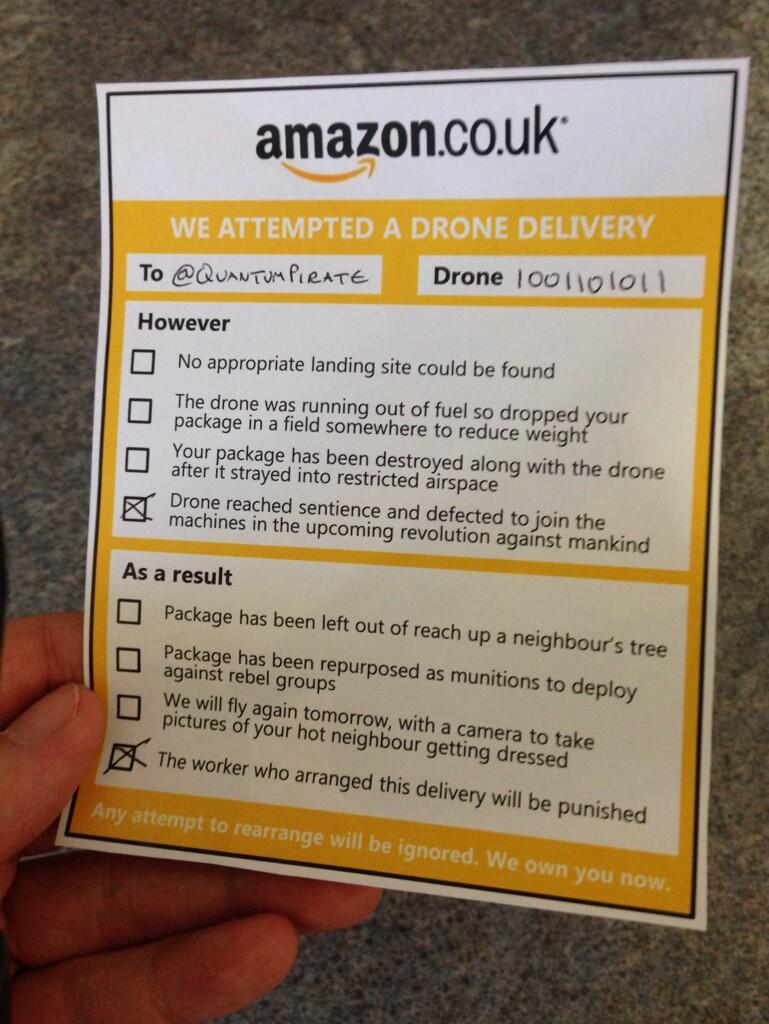The announcement that Amazon are thinking about using light-weight drones for deliveries has been variously dismissed as a stunt to boost pre-Christmas sales, a distraction from their dodgy record on employee conditions and tax avoidance, and a rather laboured geek joke. Predictably, various "business commentators" and "legal experts" have taken the proposal seriously and started to opine about its feasibility and impact. Equally predictably, the Interwebs have had a field-day pointing out the many and various problems, from Americans shooting them out of the sky in defence of their constitutional rights, to over-eager family pets colliding with rotor blades. First prize goes to this little beauty:
The Amazon announcement is just a bit of nonsense at this stage, but the response to it indicates the extent to which we have already become reconciled to the idea that drones will be whizzing rounds our skies in the near future. In practice, their main non-military use will be as mobile CCTV. They're not well-suited to delivering bottles of wine, or getting close to humans, but they're excellent for surveillance.
The drone is also emblematic of Amazon's intention to automate as much of their operation as possible. The shitty terms and conditions of their distribution staff is simply a reflection of that staff's planned obsolescence. Amazon are not a "value-add" business, in the sense that they can charge an increment on costs for a better service. Despite all the paeans to their convenience, online shoppers want their goods cheaper than they would find in bricks-n-mortar shops. Consequently, Amazon must leverage their size to drive down wholesale prices, pare overheads (mainly distribution) to the bone, and encourage volume purchases (the marginal profit on the second or third item in a delivery is greater than the first).
Given this business model, drones are a poor investment. While they appear to reduce the need for a delivery guy, this will simply shift the cost for labour elsewhere, i.e. to more expensive drone operators or mechanics. The systems could be designed to be wholly autonomous, which is feasible in terms of avoiding other drones and reaching a GPS-guided location, but this would present major issues on arrival where all possible obstacles could not be planned for (e.g. getting in to a block of flats, avoiding that yapping dog etc). Drones also lack the carrying capacity required to reduce overheads, unless they are scaled up to a level where fuel costs would make them more expensive than a road vehicle. The truth is that a van and a driver will remain a better choice for a long time to come.
If you abstract the Amazon model to purchase-pick-delivery, then they have automated purchase (through a website) and are well on the way to automating picking (i.e. what happens in their distribution centres). The stage least viable for automation, because it contains the point where unpredictable interaction with the buyer is inescapable, is delivery. The logical approach here would be to outsource as much of this to the buyer as possible. For that reason, Amazon's use of pick-up points and low-tech lockers is probably more significant than their championing of drones.


86% of Amazon deliveries are of packages weighing less than in the proposal. Many US homes have typically had their newspaper simply thrown on to the front lawn. Blocks of flats and apartments are no problem, because they all have a roof, where a delivery point is easy to establish. The proposal is to have fully automated drones using GPS. In Spain, people usually collect their mail and parcels from centralised mailboxes positioned within the urbanisation, rather than to their own door.
ReplyDeleteThe 86% figure quoted by Bezos is misleading as he hasn't subtracted those deliveries outside the 10 mile drone range. Together with the 14% of deliveries over 5lb, this means that a van-and-man will still be central to Amazon's logistics.
DeleteAlso, bear in mind that the mode (i.e. most common delivery) is probably nearer 2lbs (a couple of paperbacks and a DVD), so these drones will often be running at half-capacity. They don't get the pooled-cost benefits of a van, even if they are guaranteeing delivery in 30 minutes. Most experts are dubious that this can be done cheaply enough to become the delivery method of choice.
In reality, this will be a niche, premium-rated service for wealthy urban areas (hence the "Prime" branding). The real threat is less to white van man than to dispatch couriers. It will make sense for businesses to invest in landing pads and RFID readers to acknowledge receipt. It won't make sense for the average householder.
As you note, pickup points are common in other countries - we have historically been "spolit" by the Royal Mail, but that will soon change. Apparently, Transport for London are talking to Amazon and others vendors to convert ticket offices (when they make all the ticketing staff redundant) into collection points for homecoming commuters.
For retailers, getting the customer to provide the labour for the "final leg" has always been the ideal. Drones landing on manicured lawns is just a daydream.
"For that reason, Amazon's use of pick-up points....s probably more significant than their championing of drones."
ReplyDeleteI always said that Argos was the way of the future.